This page is in progress, and
some of the statements on here have already been disproved or cast in serious
doubt. © 2005 ICHR -- Please give the researchers credit if you
do copy anything from here.
An attempt at tracing the origins of the Champagne color gene
The
Search
In
1999, I emailed Dorothy Beardsley-Smith (now deceased, sadly), an American Cream Draft Horse breeder
in California, to ask her to help us determine whether the breed was basically
gold champagne in color. She replied to me that some of them speculated
that the breed - and thus color - might have derived from the now-extinct
Hanoverian Cream.
I
immediately contacted everyone I knew and didn't know who might have more
information on this. Only a few had anything to say on the subject at
all. Dr. Sponenberg said he thought the color of the ACDH's came through a
Mustang of Spanish southwestern U.S. descent. The present-day Hanoverian
people said they had never heard of such a thing as a cream-colored Hanoverian, and it surely would have been
considered undesirable.
Finally,
in August 2001, Carolyn Shepard found, and emailed me, an excerpt from an old
issue of the Palomino Magazine from the 1940's, which mentioned the Hanoverian
Royal Creams (see below).
Around
that time Julia Lord, another online friend, was emailing me excerpts from old
books she had read, about the colors of dun, palomino and champagne (see
below). We shared the Hanoverian Cream information with her, and she
sic'ed a historian friend of hers on it. Soon, she was sending me links,
which I then followed to others, many mentioning "the Creams" and the
British royal family.
But
the coup de grace was when Julia's friend suggested a particular book
which mentioned "the Creams" quite a lot, scattered throughout
it. She was kind enough to tell me the title, and I (and Carolyn and she)
all promptly ordered used copies online. It's called The Royal
Office of Master of the Horse. Mine was delivered at blinding
speed, and I have found it to be an incredible treasure trove of
information and pictures.
I've
attempted to report the essence of all the above information, below:
Here is a lot of that info I've collected:
The
Palomino Horse magazine excerpt that Carolyn mailed me:
"Hanoverian
Royal Creams are sometimes mentioned in connection with Palominos,
although any close association is now doubtful. The Hanoverian Royal
Creams were brought to England from Prussia by George I in 1714, but it is
generally believed they originated in Spain. (Although John Lawrence,
writing in 1809, says these animals 'may not improbably be of Persian
origin'). Some say Prussian nobles received such horses for services in
the Spanish army."
"Hanoverian
Royal Creams were a coach breed, more buff or ivory than golden, with
light but not white mane and tail. They had pink skins and eyes with white
irises and red pupils, and often had coarse heads with Roman noses, so
would not be admired by modern Palomino breeders."
"From
1724 to 1921, with few exceptions, these horses were always used on State
occasions, such as the opening of Parliament. They were bred at the royal
stables at Hampton Court. They dwindled in numbers until in 1921 the
remaining Royal Creams were sold, and no longer used by British royalty.
Most of the animals went to circuses, but a few were purchased by Sir Hugh
Garrard Tyrwhitt-Drake, who is trying to preserve the strain."
|
Julia's
notes from an older book called "America's Horses and Ponies",
published in 1969.
Under
"Color Breeds" they have "Albino",
"Palomino", and "Buckskin".
Here
is a quote Julia sent from the book:
"There
is another kind of palomino, and although the PHBA does not register it,
the PHA does. The difference between the two is that the second kind has a
pink or yellow skin instead of black. The coat of the light-skinned
palomino stays gold the year around, with the winter coat slightly darker,
but the dark-skinned palomino's coat may turn cream or white in the
winter, only regaining its golden sheen when the winter coat sheds
out."
(My
note: this is a very good differentiation of Gold Champagne from
cream-gene-based Palomino)
Another
quote from the same book, on the American Cream Draft: "To
get the proper shade of cream each time, only horses with pink skins are
used, for dark-skinned creams have changeable coat colors. The eyes are
amber, an unusual color and a shade peculiar to the American Cream.
The young foal's eyes are almost white, but as the animal matures they
gradually darken until a deep honey color is reached."
(Again,
my note: I have found this to be true of the ACDH's I have seen and
heard about, and also -- of course -- of GOLD CHAMPAGNES.)
|
This, plus photos and information from Chris
Ertl, my visit to Carol Pshigoda's Cream
Acres, and other reading, convinced me that the ideal ACDH was and is a true
gold (or gold cream) champagne. But that's for another page. This search
took another turn here, as I looked to see if the Hanoverian Royal Creams were
the origins of the American Cream Draft Horse. The timing was almost
right; the creams were dispersed in 1920, and Old Granny, the foundation mare of
the ACDH breed, appeared in Iowa in 1911.
First,
the book recommended by Julia's friend:
The
Royal Office of Master of the Horse
by
M. M. Reese
Threshold Books, London, 1976 (out of print)
All graphics and information (not direct quotes) in this box are
from that book. Click on the thumbnail pictures to see the full
sized ones.
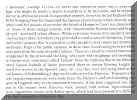 |
How
Hanoverian Creams got to England in the 18th century; some horse
color lore; and how they came from Spain to Hanover, as "Isabels",
in the 15th century. |
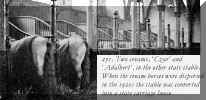 |
The
caption from the book says a lot. Look closely to see the
rumps continue all the way down the row of stalls. They all
matched, and they bred true to color. |
 |
George
III used this "Cream" as his personal charger when it
turned out to be not strong enough* for coach work. Note the
amber color of the iris and the "swirled" pattern in the
leg color, both common Champagne traits. |
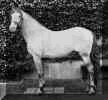 |
"Pistachio",
"a Cream stallion". Photo taken at the Royal Mews
(stables). |
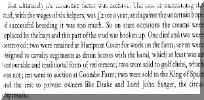 |
What
became of "the creams"? Here is all we know so far. |
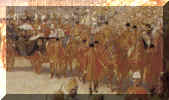 |
This
event (with "eight creams") is described by Queen Victoria
in her diary, which I found here:
oops, sorry, that site has been redesigned and the link is now
bad. Please be patient while I repair these diary links. |
|
Another diary entry of Queen Victoria's, mentioning "six creams",
here: http://www.royal.gov.uk/history/journ06.htm
Please be patient while I repair these diary links. The diaries appear to
have been completely removed from the official British royal site.
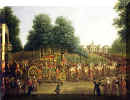 |
Julia
also sent this
link, which has a photo at the bottom of George III being pulled by
Creams (click thumbnail at left to see full size): |
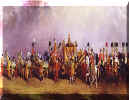 |
And,
from this
site:
"The Coronation procession of William IV (detail of the
frieze by Richard Barrett Davis on display in the Royal Mews)."
(click to see full-size, undistorted version) |
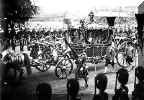 |
The
coronation of Edward VII
Not sure if these horses (pulling the coach) are the Creams or later
grays. Need a date for the event. |
|
|
|
|
This
page has a much later reference to the (now) Queen Mother calling the the
light golden color of some Fjordhorses "Champagne", quoted below:
Queen
Mother
|
Janet
Kidd was hooked. She arranged the importation of further Fjord mares and
the stallion Jacob who was renamed Viking. Her love of the breed grew
with her successes and soon people were clamouring to buy these
beautiful horses. The Maple Stud was famous. It had been the home of
Hanoverians for many years and their successes were well known and well
respected. Now these cream coloured invaders whom the Queen Mother
once referred to as the colour of champagne, had virtually taken
over. (italics mine)
|
This
is the earliest reference I can find to that color name ("champagne")
in Europe so far. It's disconcerting that, although the passage makes a
reference to Hanoverians, the term here is being applied to the color of the
FJORDS, which do not carry the actual champagne gene.
Other
possible champagnes of possible importance:
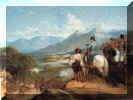
|
Wellington,
Napoleon's British arch-enemy, from internet military-art-sales site, on a
cream or gray. Click to enlarge a bit.
|

|
An
enlarged antique postcard, from http://www.eBay.com
, I believe. Click to enlarge. I cut a lot of it off, but it's
still pretty big. Looks like the Napoleon toy figure is mounted on a
Cream. There is a patriotic quote written on it in French.
|

|
The
Queen Mum's coach, from this
book.
|

|
The
coronation of George V, coach pulled by "creams", from a
postcard, provided by Carolyn Shepard. Click to enlarge.
|
"Elector Ernest Augustus (1629 - 1698) adopted the white horse for
his coat of arms. The Electress Sophia began the development of the famous white
or cream Hanoverian coach horses. A long tradition already existed in preference
for white German horses. The Hanoverian Creams, also known as Isabellas, were
used in British royal processions from the reign of George I to George V, when
they were replaced by the Windsor grays."
Notice
these interesting excerpts from the
"The
Palomino Horse Association is the Original Palomino Registry incorporated
in 1936. Today's Palomino Horse Association is the continuation of the
registry which officially began in California in 1935, when Dick Halliday
registered the golden stallion El Rey de Los Reyes to begin the records of
his envisioned true Palomino Breed. Mr. Halliday researched the
golden horses for many years. He started writing magazine articles that
brought the Palomino into public attention. His articles created a great
deal of interest in the Palomino, and within a few years, hundreds of
breeders were specializing in the production of this color."
"The
Palomino has come down through the pages of history. There are stories of
the Golden Ones linked to the Crusades; the mail-clad Crusaders saw them
on the battlefield when they fought the desert chiefs of Saladin who rode
them. You will find stories about them among the Arabs and the Moors.
During the days of the Crusades the Emir Saladin presented
Richard-Coeur-de-Lion with two splendid war horses, one was a gray and the
other a Golden Palomino. The place of origin of the Palomino probably
never will be conclusively determined. Myths and legends of various
countries shroud the beginnings of the golden horse which is no modern
phenomenon. The golden horse with ivory-colored mane and tail appears in
ancient tapestries and paintings of Europe and Asia, as well in Japenese
and Chinese art of past centuries."
"Nowhere
has the history of the Palomino been recorded, but most horsemen agree
that all light bodied horses have descended from the Arab and the
Barb."
"These
splendid golden horses were favored by her Majesty Ysabella de-Bourbon,
that beloved queen who pawned her jewels that the expenses of the
expedition which discovered the New World might be paid. In the Remuda
Real of Spain, Queen Ysabella kept a full hundred of these animals and as
the chosen favorites of the crown, only the members of the royal family
and the nobles of the household were permitted to ride them. A commoner
might not even own one. It is recorded that Queen Ysabella sent a Palomino
stallion and five mares to her Viceroy in New Spain, which is to say
Mexico, to perpetuate the golden horse in the New World. From this
nucleus, the blood spread into Texas plains, and from Texas it came to
California."
(My
note: the golden horses of Queen Isabella are said, in the "Master of
the Horse" book, to be foundation stock of the Hanoverian
Creams. Today, the AFCCC, the French champagne horse registry,
describes a dark pointed horse in their brochure as "Isabelle
+ champagne = ivory". )
The
word "Palomino" is a Spanish surname. Many feel that Palomino is
only a color and not a breed, which is true in that the color of Palomino
comes in all breeds, but the Palomino of Spanish times, the Golden Dorado,
was as close to being a breed as any strain of horse. The Dorado was of
Arabic-Moorish-Spanish blood and breeding, closely akin to the Arabian and
the Moorish Barb. The Palomino of Spanish
times was not bred by being crossed with sorrels. The Spanish had many
shades of golden horses, and when they did use "Corral
Breeding", a light color Palomino mare would be mated with a very
dark-colored Palomino stallion. This point has been noted in an old book
and printed in Barcelona in 1774."
(My
note: this is the way one would expect GOLD CHAMPAGNES to be bred.
Cream-gene-based Palominos would produce cremellos and chestnuts if bred
this way!)
|
SO
...
According
to the "Masters of the Horse" book, the champagne color *may* go back
as far as Spain in the 15th century (1400's) when Queen Isabella presented
horses called "creams" to certain German knights in reward for service
in the Spanish army. In 1714 they were still being bred in Germany,
including Hanover, and sometimes called Isabels because of the queen.
THE LATEST: received August 26, 2004 from Julia Lord:
>From another list:
--------
Subject: Notice in Virginia Gazette
Hi (list member),
As you were compiling a list of imported horses to England I thought you
might be interested in an item from the Virginia Gazette of 8 July 1737,
reporting on news from London.
'On Saturday last, about Two 'oClock, his Majesty, attended by his Grace the
Duke of Richmond, the Lord in Waiting, and Sir Robert Walpole, went in a Chair
to the Royal Stables in the Meuse at Charing-Cross, and viewed the Eight
beautiful Horses which were landed at the Tower on Friday last, Four of which
were Mouse-color'd, and the other Dun and somewhat Cream-colour'd; and according
to their appearance, and their being so finely moulded, the Gentlemen skilled in
Horsemanship are of the Opinion, that they are the best they ever saw bred in
Germany.'
AND
DEFINITELY...
King
George I of Hanover brought "the famous cream horses" from his
homeland into England during his reign from 1714 - 1727. They pulled the royal
state coaches until 1920 when the herd was dispersed for economic reasons. The
paintings and photos all show apparent black-based champagnes. (As shown
in the few in the pertinent box, above.)
MORE
COMING
Napoleon
used these same "Hanoverian Creams" to pull HIS royal carriage, which
gave the British royals a fit. I'll have more info on that here,
soon. I have found a photo of this!
There
is a possible Appaloosa connection. Not sure if we'll get more into that,
but the first graphic of text from the Masters of the Horse book, in the box
above, says that "some of the creams from Hanover were bred to
"certain tiger-coloured horses, apparently creams with darker spots."
American
Cream Draft Horses
Sadly,
I haven't found a *direct* connection to the
American Cream Draft Horses yet, especially with
the horses in these pictures all being E based (dark points) (with one possible
exception so far.) But it's pretty obvious that the color came to America
from Europe, either from Spain in the 1400's (when Queen Isabella sent a small
group of her precious golden herd to Mexico, "New Spain") or from
England, or France, or many different places, in the 1900's.
Perhaps
right around 1911, around when the British crown's Hanoverian Royal Creams were
nearly ready to be sold off, and Old Granny "appeared" in Iowa...
I
have seen one older shipping document refer to the color as "dun",
which of course it is not, but that may be one reason why it was not correctly
identified in this country until recently ... that and the fact that many were
believed to simply be regular "cream-gene-based" Palominos and
buckskins but with light skin ...
I've
always said that discovering champagne horses alive today seems like finding
"buried treasure", but finding the history of the champagne color is
-- perhaps -- even more exciting.
Anyone who wants to help, please contact me at bak@one.net
. Thanks, and hope you enjoyed this page!
|